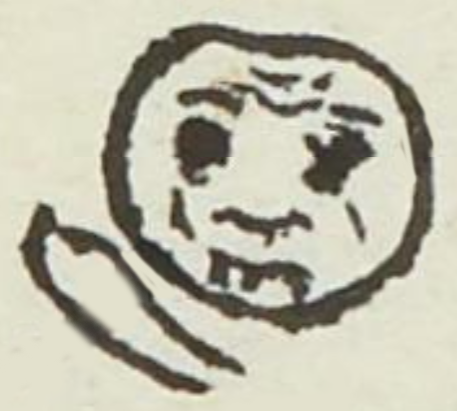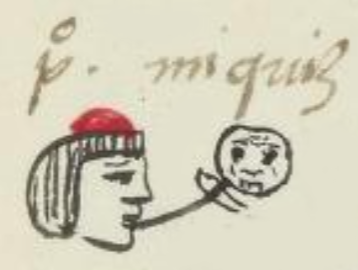Miquiz (MH874r)
This black-line drawing of the simplex glyph for the personal name Miquiz (“Death”) is attested here as a man’s name. The glyph shows a frontal view of a face with a furrowed brow and perhaps teeth sticking out from the mouth. The eyes seem to be blacked out, as though they are holes (something like one would see on a skull). A partial bone (perhaps what was going to be a cross bone) may be below the face, on the left.
Stephanie Wood
This is not the usual skull employed for the miquiztli (death) day sign in the 260-day divinatory calendar called the tonalpohualli. The man with this name may have born on that day in the calendar. But we do not have the numerical value that would have accompanied the death sign, a number from 1 to 13. The number may have faded from use or perhaps it was suppressed to disguise the name's association with the divinatory calendar.
The iconography of miquiztli and related word will vary considerably across manuscripts. One example, below, is very colorful. The glyph shown below for the verb "to die" (miqui) has what is called a starry or stellar eye, which associates it with the celestial realm. Calendrics were important in the Nahuas' religious view of the cosmos.
Stephanie Wood
po. miquiz
Pedro Miquiz
Stephanie Wood
1560
Jeff Haskett-Wood
muerte, craneos, calendarios, nombres de días, nombres de hombres

miquiz(tli), death, https://nahuatl.wired-humanities.org/content/miquiztli
Muerte
Stephanie Wood
Matrícula de Huexotzinco, folio 874r, World Digital Library, https://www.loc.gov/resource/gdcwdl.wdl_15282/?sp=820&st=image.
This manuscript is hosted by the Library of Congress and the World Digital Library; used here with the Creative Commons, “Attribution-NonCommercial-ShareAlike 3.0 License” (CC-BY-NC-SAq 3.0).






